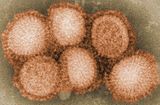
Back فيروس الإنفلونزا أ H3N2 Arabic H3N2 German Influenzavirus A subtipo H3N2 Spanish Virus de la grippe A (H3N2) French H3N2 HE H3N2 Croatian H3N2 Hungarian H3N2亜型 Japanese H3N2 Korean Influenza A subtipo H3N2 Portuguese
| Influenza A virus subtype H3N2 | |
|---|---|
| Virus classification | |
| (unranked): | Virus |
| Realm: | Riboviria |
| Kingdom: | Orthornavirae |
| Phylum: | Negarnaviricota |
| Class: | Insthoviricetes |
| Order: | Articulavirales |
| Family: | Orthomyxoviridae |
| Genus: | Alphainfluenzavirus |
| Species: | |
| Serotype: | Influenza A virus subtype H3N2
|
| Notable strains | |
| Influenza (flu) |
|---|
 |
Influenza A virus subtype H3N2 (A/H3N2) is a subtype of influenza A virus (IAV). Some human-adapted strains of A/H3N2 are endemic in humans and are one cause of seasonal influenza (flu).[1] Other strains of H1N1 are endemic in pigs (swine influenza) and in birds (avian influenza).[2] Subtypes of IAV are defined by the combination of the antigenic H and N proteins in the viral envelope; for example, "H1N1" designates an IAV subtype that has a type-1 hemagglutinin (H) protein and a type-1 neuraminidase (N) protein.[3]
All subtypes of IAV share a negative-sense, segmented RNA genome.[1] Under rare circumstances, one strain of the virus can acquire genetic material through genetic reassortment from a different strain and thus evolve to acquire new characteristics, enabling it to evade host immunity and occasionally to jump from one species of host to another.[4][5] Major outbreaks of A/H3N2 strains in humans include Hong Kong Flu (1968–1969), and Fujian flu (2003–2004).
Each year, three influenza strains are chosen for inclusion in the forthcoming year's seasonal flu vaccination by the Global Influenza Surveillance and Response System of the World Health Organization (WHO). Since 1999, every annual formulation has included one strain of A/H3N2 as well as two other influenza strains - together representing strains thought most likely to cause significant human suffering in the coming season.[6][7][8]
- ^ a b "Influenza A Subtypes and the Species Affected | Seasonal Influenza (Flu) | CDC". Centers for Disease Control and Prevention. 2024-05-13. Retrieved 2024-06-17.
- ^ Jilani TN, Jamil RT, Siddiqui AH (November 30, 2020). "H1N1 Influenza". H1N1 Influenza in StatPearls. StatPearls. PMID 30020613. Archived from the original on 12 March 2020. Retrieved 25 August 2020.
- ^ CDC (2024-02-01). "Influenza Type A Viruses". Centers for Disease Control and Prevention. Retrieved 2024-05-03.
- ^ Shao W, Li X, Goraya MU, Wang S, Chen JL (August 2017). "Evolution of Influenza A Virus by Mutation and Re-Assortment". International Journal of Molecular Sciences. 18 (8): 1650. doi:10.3390/ijms18081650. PMC 5578040. PMID 28783091.
- ^ Eisfeld AJ, Neumann G, Kawaoka Y (January 2015). "At the centre: influenza A virus ribonucleoproteins". Nature Reviews. Microbiology. 13 (1): 28–41. doi:10.1038/nrmicro3367. PMC 5619696. PMID 25417656.
- ^ "Seasonal Flu Vaccines | CDC". Centers for Disease Control and Prevention. 2024-03-12. Retrieved 2024-08-19.
- ^ "Global Influenza Surveillance and Response System (GISRS)". World Health Organization. Archived from the original on October 3, 2011. Retrieved October 22, 2019.
- ^ Anker M, Schaaf D, World Health Organization (2000). WHO report on global surveillance of epidemic-prone infectious diseases (PDF) (Report). World Health Organization (WHO). hdl:10665/66485. WHO/CDS/CSR/ISR/2000.1. Archived (PDF) from the original on 31 October 2022.